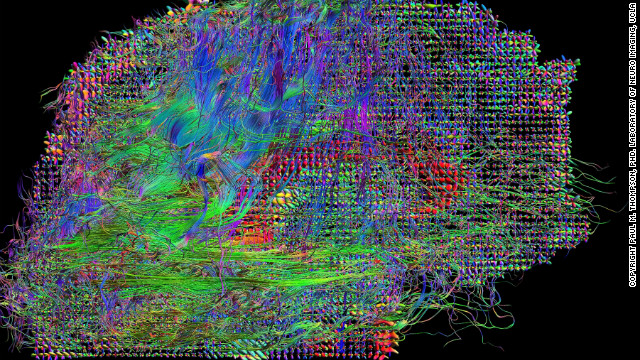Tagged: Connectome
Connectome Progress Report
The Human Connectome Project (HCP) has started trials on volunteers with a state-of-the-art scanner.

New maps of the networks of live brains could lead to better treatments for neurological disorders
Today’s technology allows neuroscientists to map the brain’s connections on an unprecedented level of detail. The ultimate goal of the HCP is to create a map, or connectome, of every neuron and synapse to better understand how the brain works. A better understanding of the brain means a better understanding of brain disorders like schizophrenia or autism, which in turn means better treatment.
More
Genome or Connectome?
Sebastian Seung is a professor of computational neuroscience and physics at MIT. His research in the neuroscience field involves "connectomes," or the map of connections between and among neurons. The endeavor of investigating and mapping connectomes began in the 1980s and jumped off with the elucidation of the complete connectome of the worm C. elegans in 1986. While C. elegans has about 300 neurons, humans have about 10 billion neurons and ten times that number of connections. These connections can grow and change with and from neural activity and experience, combining to permutations exponentially greater that those of DNA and its four bases. Seung proposes that we "are our connectomes" rather than our genomes, implying that our thoughts, experiences, emotions, and consciousness itself may have a purely neural basis. To refrain from any more spoilers, he artfully expands and explains his hypothesis in the above TED talk that it is surely worth viewing. For a greater philosophical inquiry inspired by his ideas, is our matter all that matters?
Connectomics is the name. Connections are the game.
You are unique, just like everyone else.
Connectomics is the study of the structural and functional connections among brain cells; its product is the "connectome," a detailed map of those connections. The idea is that such information will be monumental in our understanding of the healthy and diseased brain. Sebastian Seung thinks that a complete connectome of the human brain will be one of the great prizes in 21st-century neuroscience.
Efforts to construct brain connectomes are split into two categories: ones that use imaging techniques like MRI, PET, and DT, thus focusing on macroscopic connections or tracts; and those that use electron microscopy to map the tinniest of axons (0.2-20 microns in diameter) and individual synapses.
While this may sound daunting, it also seems the obvious thing to do in order to really understand how the brain works. After all, don’t all our memories, personalities, and behaviors dependent on the structure of the brain, down to the microscopic level? So why is connectomics so new? Because the three-pound enigma that can contemplate all things big and small – from protons and electrons, to planets and stars, to galaxies and the whole universe – contains more parts than anything we’ve ever studied before. The human brain, we’ve been told, holds 100 billion neurons, with close to one quadrillion synaptic connections total; storing all of that information in one brain would take one Exabyte of data (that’s one trillion Gigabytes).
Jeff Lichtman and colleages at Harvard remain hopeful. They are developing novel tools to automate the tedious task of scanning brain slices. They expect the connectome to reveal differences in the way healthy and diseased brains are wired.
The effort is laudable, considering its scope and ambition, but it begs the question: does all behavior, experience, perception, etc depend on the structure of synapses and connectivity of neurons? More pointedly, does structure determine all function – chemical and electrical? Sure, larger synapses or more dendritic spines make stronger connections and more efficient transmission of information, but a snap-shot connectome won’t take into account temporal dynamics and enzymatic processes, which play a big role in the active brain.
In his TED talk, Sebastian Seung says that to test the hypothesis that “I am my connectome,” we could try to read out memories from someone’s connectome. But memories are not just synaptic connections – they are also assemblies of neurons in time or firing sequence. The connectome does not take those into account. And Seung fails to explain how we could actually verify any of those personal memories, since current methods of constructing a connectome involve cutting the brain into thousands of 30-micron slices.
If we could devise some non-invasive methods to construct a human connectome at the synapse level, what ethical issues would we face? Could a personal connectome be the ultimate breach of privacy? Could it redefine or “undefine” what we consider to be normal brains/mental states?
Constructing a comprehensive human connectome is a great challenge. A bigger challenge would be to model the electrical dynamics of the 100 billion human neurons. But perhaps the most important quest for neuroscience isn’t building a connectome, but learning how neuronal activity creates experience.
Neurocartography - Narayanan Kasthuri and Jeff Lichtman via NIH Public Access
Sebastian Seung: I am my connectome - TED.com
Seeking the Connectome, a Mental Map, Slice by Slice - NYTimes.com